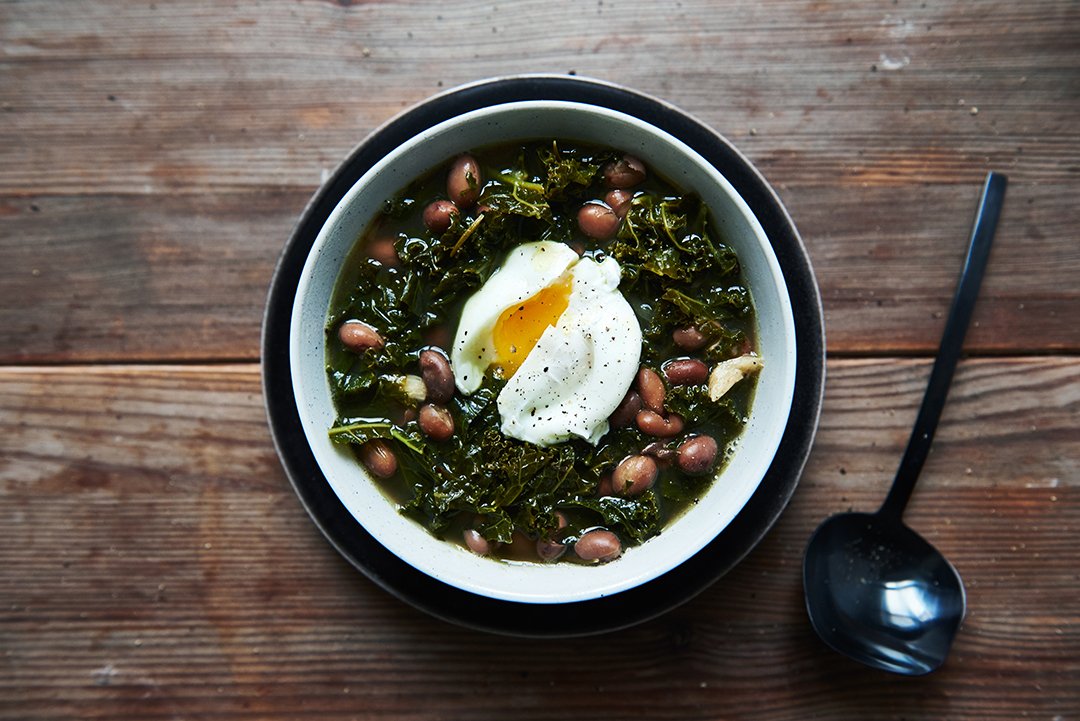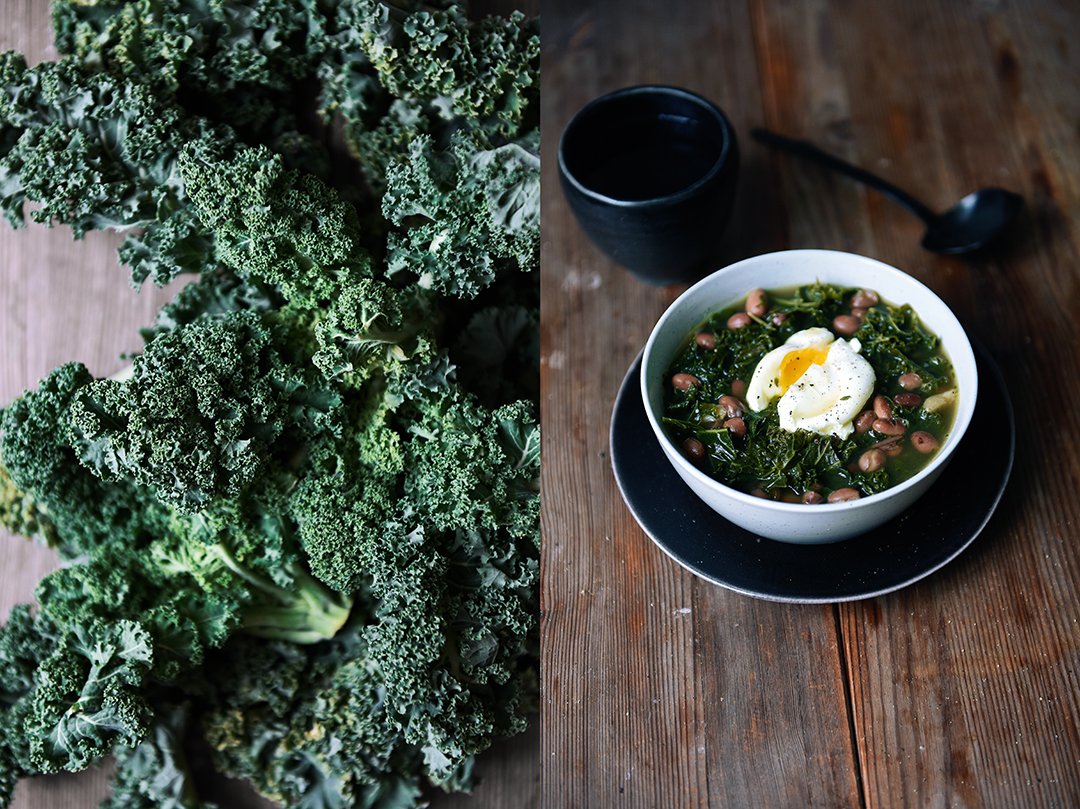Clean-Out-The-Fridge Soups
Food52 asked me about my approach to soups. Not just any soups, but big-flavor, clean-out-the-fridge soups to cure the winter blues. I love them now, but that wasn't always the case. We're like friends that had to learn to love each other. So I shared our bumpy love story, my basic soup formula, and three soup recipes from my new book, 365, on food52.com. Converted and convinced that a soup can be one of the best things to find on your dining table after a long day of work, I also decided to share my article on these pages here (and you can find two of the recipes from 365 below):
I have a new habit, recently, I often have soup for lunch, which is actually my breakfast as I only have green tea with lemon in the morning. My relationship with liquid foods wasn’t always so harmonic. Soups and stews are very popular in Germany, thick lentil, pea, or potato soup enriched with smoked sausage (Knackwurst or Knacker) is a German winter classic. As a child, I ate it, but I wasn’t particularly fond of it. There was something missing, or maybe I just wasn’t ready yet. Then the eighties came, the Nouvelle Cuisine reached home kitchens and all of a sudden soups where always puréed and as bright as candy: yellow squash, purple beet, squeaking green pea pod. Shallow bowls filled with colorful compositions, smooth and shiny, conquered the menus but unfortunately not my palate. Despite their vibrancy, they didn’t excite me. This is essential to me, and my taste buds - I want, I need food to excite me. So I took a break of many, many years until I found the kind of soup that I like.
Fast-forward to today and it has become a constant in my weekly culinary routine. My basic soup formula is very simple:
1. Canned legumes and dried lentils that don’t need to soak overnight. I always have a vast collection of cans filled with butter beans, cannellini, borlotti (cranberry) and kidney beans on my pantry shelves, and bags of black beluga lentils, dark green French Puy lentils, and yellow and red lentils. Legumes make a soup rich and wholesome, they add heartiness and a nutty touch. It's what turns a light soup into a proper meal.
2. Cleaning out the vegetable drawer. This drawer is a treasure box that needs to be emptied once in a while. Leafy vegetables, kale, chard, and spinach that start to wilt, sturdy roots like potatoes, parsnip, and beets that lie forgotten, the whole range of winter and summer squash, fresh beans, peas, and tomatoes. Every season has its produce that’s just waiting to crown a soup.
3. Using homemade or quality store-bought broth. My mother taught me to always cook my own broth, with leftover vegetables, chicken, duck, and beef bones, with fresh herbs and whole spices like allspice, peppercorns, and juniper berries. And a bay leaf, always a bay leaf. I then freeze it in 4-cup portions to have my tasty broth right at hand whenever I need it. I never use instant broth as I find it adds an artificial flavor. Broth is the base of a soup, it adds its taste to all the other ingredients and therefore deserves utmost attention.
Soups can easily follow the seasons and the cook’s mood. I want to throw them together spontaneously, quickly, without too much planning or overthinking. A quick look in the pantry and fridge and my mind starts playing. A soup is a simple, a frugal dish, but that doesn’t mean it can’t be exciting. Playing with flavors is a boundless game, playing with textures is at least as rewarding.And varying toppings allows the cook to serve a soup repeatedly without anyone noticing. Crunchy bacon cubes or dukkah, a dollop of velvety mascarpone or ricotta, a fried or poached egg, or a crumbled hardboiled egg, fried herbs like sage or rosemary, or roasted fruit like grapes, apple, pear, or apricot.
In my new book, 365: A Year of Everyday Cooking & Baking, I share a recipe for each day of the year, following the seasons and also the rhythm of the week, from Monday to Sunday, from quick and simple weekday dishes to luscious - and more time-consuming - roasts, stews, and cakes on the weekend. Soups are a constant treat in this rhythm, especially during the colder part of the year. There’s a cozy kale and borlotti bean soup for example, cooked in a flavorful duck broth (recipe from 365 below and on food52.com) - a clear vegetable broth works just as well - and it's the perfect cure for winter blues. It’s crowned with a poached egg and when you cut through the yolk and let it run into the broth, it adds a creaminess that’s even better than cream; as an added bonus: it only takes twenty minutes for dinner to be ready.
A golden squash, parsnip, and sweet potato soup - basically the tasty finds of a fridge clean out - could be kept chunky but with a nod to the good old Nouvelle Cuisine, I purée it and also go for a more extravagant topping that makes this recipe fit for a Christmas table. Red grapes roasted with woody rosemary until soft and shriveled, and a dollop of whipped orange mascarpone turn this dish into a festive stunner (recipe from 365 onfood52.com). However, crunchy bacon bites would make it even heartier and also quite appealing.
One of my favorite soups is the minestrone because there are no rules and limitations. Every vegetable, every combination that the cook finds fitting, works. For my green minestrone, I use green beans, peas (which I always have in my freezer), and zucchini, but that’s not set in stone, and add tiny meatballs refined with lime and arugula. It gives it a fresh citrusy note, similar to lemongrass. This is the speediest of all weekday soups. Once the meatballs are mixed and shaped, the entire soup and meat only need to cook for about 5 minutes (recipe below).
So what changed my mind, what made me fall in love with soups after so many years of skepticism? First, the taste, I had to find combinations that excite me, but then there’s something else. Sitting in front of a bowl of steaming soup is one of the coziest things I can think of. It makes me feel good while I eat it and this feeling stays. A soup is a friend of my mind and my body.
Kale and Borlotti Bean Soup with Poached Eggs
from ‘365 – A Year of Everyday Cooking & Baking’ (Prestel, 2019)
Serves 4
For the soup
Olive oil
1 medium onion, cut into quarters
2 large cloves garlic, cut in half
7 ounces (200 g) trimmed kale leaves, cut into strips
5¼ cups (1.25 liters) homemade or quality store-bought duck, chicken, or vegetable broth, hot
1 small bunch fresh thyme
1 medium sprig fresh rosemary
1 large bay leaf
Fine sea salt
Finely ground pepper
1¼ cups (250 g) drained and rinsed canned borlotti (cranberry) or pinto beans
For the topping
4 to 8 large eggs
Coarsely ground pepper
For the soup, in a large pot, heat a splash of olive oil over mediumheat and sauté the onion and garlic, stirring, for a few minutes or untilgolden and soft. Add the kale, stir, and cook for 1 minute then add the hotbroth, thyme, rosemary, and bay leaf. Season to taste with salt and finelyground pepper, reduce the heat, and simmer for 20 minutes or until the kale istender. Remove and discard the herbs then add the borlotti beans and cook for 1minute. Season to taste with salt and finely ground pepper and keep warm.
For the topping, bring a small saucepan of salted water to a low simmer.Crack 1 egg into a small bowl. Hold a large spoon just over the surface of thewater and gently pour the egg onto the spoon. Lower the spoon into the waterand hold until the egg white starts to turn white then use a tablespoon togently scoop the egg off the large spoon. Poach the egg for 3 minutes. Using aslotted ladle or spoon, transfer the egg to a plate. Poach the remaining eggsthe same way, adjusting the heat as needed to maintain a low simmer. It’s bestto poach 1 egg at a time, but you can cook 2 at once.
Divide the soup among bowls, place 1 to 2 eggs in the middle of each bowl, and sprinkle with a little coarsely ground pepper. Cut the tops of the eggs with a sharp knife and serve immediately.
Green Minestrone With Lime-Arugula Meatballs
from ‘365 – A Year of Everyday Cooking & Baking’ (Prestel, 2019)
Serves 2-4
14 ounces (400g) ground beef
2 large cloves garlic, crushed, plus 1 large clove garlic, cut in half
2 ounces ounces (60g) arugula leaves, finely chopped
1 teaspoon (heaping) freshly grated lime zest
Fine sea salt
Finely ground pepper
Extra-virgin olive oil
3/4 pound (340g) trimmed mixed green vegetables (such as green beans, frozen peas, zucchini, Brussels sprouts, broccoli, or kale, cut into bite-size pieces if necessary)
4 1/4 cups (1 liter) homemade or quality store-bought vegetable broth, hot
1 tablespoon freshly squeezed lime juice
1 bay leaf
1 spring onion (green part only), thinly sliced
Combine the ground beef, crushed garlic, arugula, lime zest, 1 teaspoon of salt, and a generous amount of pepper in a large bowl and mix with your hands until well combined. Form the mixture into 38 roughly 1-inch (2.5 cm) meatballs.
Heat a splash of olive oil in a large pot over medium heat. Add the garlic and sauté for 1 minute. Add a little more oil and the vegetables and sauté, stirring, for 1 minute. Add the hot vegetable broth, lime juice, and bay leaf, season to taste with salt and pepper, and bring to a boil. Add the meatballs then reduce the heat, cover, and simmer gently for 4 to 6 minutes or until the meatballs are just cooked through and the vegetables are tender. Season to taste with salt, pepper, and additional lime juice.
Divide the soup among deep bowls, sprinkle with the spring onion, and serve immediately.



